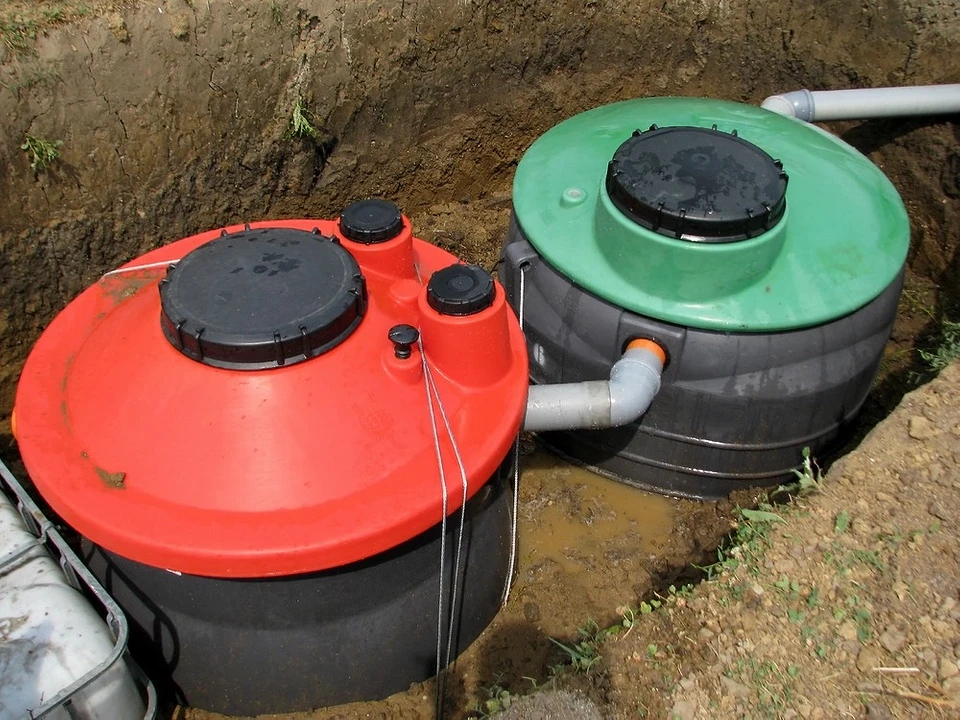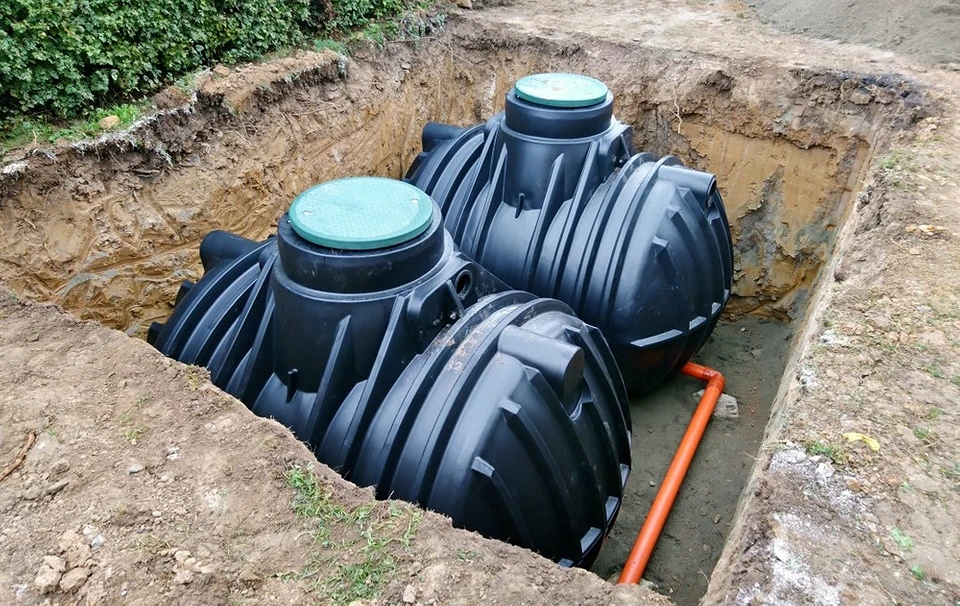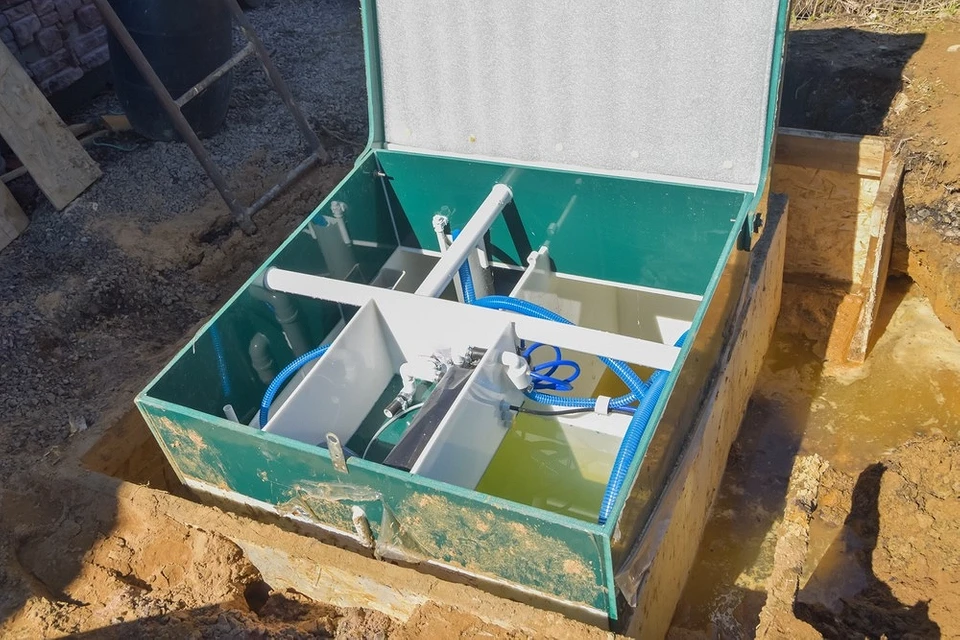We tell you what a septic tank is and what types there are. We analyze the operating principle of different types of waste disposal systems.
In a country or summer cottage area, it is not always possible to connect to a centralized sewerage system. To solve the problem of wastewater disposal, an autonomous sewerage system is installed. It is important to choose the right type of such a system in order to get effective wastewater processing and not overpay for it. Let’s look at the operating principle of different types of septic tanks .
Types of septic tanks
A septic tank is a system that collects and purifies household wastewater. There are two main types of such structures.
Accumulating
Septic tanks are analogs and modifications of a cesspool. They are designed to accumulate incoming waste. There are two types of such structures. The first is with partial filtration. These are pits without a bottom with sealed walls. They are made of concrete rings, etc. In any case, the waste gets inside the tank, where it accumulates. Some of the liquid seeps into the soil, and goes into aquifers. Considering that it is practically not purified, dirty waste contaminates the soil mixture around the storage tank. Semi-solid and solid waste accumulates, they are periodically pumped out.
The second type of storage septic tanks are completely sealed. They are made of large plastic or metal containers, the tanks are lined with brick or filled with concrete. The operating principle of such septic tanks is very simple. Wastewater flows into them and is pumped out as it accumulates. The main disadvantage of storage tanks is the need for regular pumping. It is impossible to do this on your own, since you need a special machine. You have to pay for the work of specialists. Therefore, despite the small costs of construction, storage tanks require constant cash investments due to expensive regular maintenance.

Filtering
They are also called septic tanks without pumping, but this is an exaggeration. Solid sediment sludge is also pumped out of systems of this type, but this is done much less often than from storage tanks. The main difference between filter systems is that there is no need to pump out the liquid purified in them. An independent water outflow is provided here. Only solid residue remains inside. It is small since decomposition processes take place inside the septic tank. There are two types of filter systems.
- Overflow with soil filtration. Inside such a system, incoming wastewater undergoes primary and secondary filtration, after which it is divided into solid sediment and incompletely purified water. The latter is diverted for additional purification to filtration fields or to a filter well. Overflow systems are autonomous, and do not require electricity and frequent maintenance.
- Deep bio-treatment stations. High-performance systems that purify wastewater using anaerobic and aerobic bacteria. As a result of such purification, waste quickly decomposes and is processed. The result is activated sludge, which can be used as a fertilizer, and industrial water that does not require additional purification. It is used for irrigation and other needs. Bio-treatment stations are not autonomous, they require electricity and periodic maintenance.

The principle of operation of a septic tank without pumping
Systems that operate without pumping not only accumulate but also purify wastewater. To do this, they use the principle of natural decomposition of organic matter under the influence of microorganisms. Just like it happens in natural conditions, but in an accelerated form. Let’s take a closer look at the principles of how septic tanks of different types work in a private house.
Overflow system
The filter overflows septic tank consists of several sealed reservoir chambers. They are dug into the ground and connected to each other by pipelines with a lowering level. At the outlet, a filter well or filter field is mounted for additional water purification. The system works like this.
The waste from the house enters the first tank. Here it accumulates and gradually separates into liquid and solid sediment. The process of rough cleaning takes place when the waste settles to the bottom, and a liquid suspension remains above it.
The liquid flows by gravity through the overflow pipe into the next chamber. The mechanical cleaning process is repeated, and the large particles remaining in suspension settle to the bottom. Biological cleaning is also carried out. This is done by anaerobic bacteria, which can live in an airless environment. They feed on organic matter, decomposing it into carbon dioxide, which is removed through ventilation, and water. The liquid purified in this way enters the overflow pipe and goes to the next chamber, where the process is repeated, or to the outlet of the septic tank and soil post-cleaning.
Overflow systems can consist of a different number of elements. Usually, there are two or three. The more tanks, the better the wastewater is purified. But in any case, an overflow septic tank does not provide complete purification. Water comes out of it purified by 70-75%. Therefore, it is sent for additional purification. The simplest and cheapest way is to discharge the liquid into a filter well. This is a tank with sealed walls but without a bottom. A drainage layer is arranged at the bottom, which provides additional purification before the water is absorbed into the soil.
The capacity of the well must correspond to the discharge from the septic tank. It decreases on heavy soils. Therefore, several wells are installed on clay soils. Important. If the underground aquifer is located above 250 cm, it is impossible to install a filter well. In this case, a filtration field is arranged. This is a labor-intensive and expensive option when drainage pipes are laid in rows on a gravel base, in which additional cleaning takes place, after which the water goes into the soil. The size of the field is calculated based on the volume of effluents, the type of soil, etc. If the volume of water consumption is large, the area of the field can occupy several tens of square meters.
Overflow septic tanks differ in volume, capacity, and material. You can buy two- or three-chamber plastic systems of different volumes. You can install homemade tanks. They are assembled from bricks or concrete rings, cast from concrete, or metal tanks are dug in.
In any case, the principle of how a septic tank made of concrete rings, brick, or plastic works remains unchanged. Wastewater flows from one chamber to another, where it is gradually purified. When arranging a homemade system, it is important to remember that all tanks must be sealed, otherwise the wastewater will pollute the soil mixture.

Deep biological treatment plant
The operating principle of these systems is similar to overflow systems, but there are also significant differences. Let’s figure out how a septic tank with deep biological treatment should work. Waste from the domestic sewage system enters the first tank. In this container, they are separated into liquid and solid fractions. The first one goes into the next chamber by overflow, the second one settles to the bottom. Active biological treatment takes place in the next chamber. It occurs under the influence of two types of bacteria: aerobes and anaerobes. Such symbiosis provides rapid decomposition of organic matter.
It is important to know that aerobic microorganisms are not able to live in an airless environment; they consume oxygen during their life processes. Therefore, the system is equipped with an aerator, which continuously supplies oxygen to the chamber. For this reason, septic tanks of this type are called aeration tanks. Bacteria actively clean the wastewater, after which the liquid is fed to the next chamber, where it settles again. An ultraviolet disinfector can be additionally installed here for complete disinfection of the liquid.
The system produces technical water, which can be used for household needs, such as irrigation, without additional purification. Therefore, additional purification is not required. Aeration septic tanks are effective and productive. But at the same time, they are expensive and energy-dependent. It is impossible to assemble such a system on your own. Manufacturing companies, as a rule, offer installation of septic tanks purchased from them and subsequent maintenance.

Brief conclusion
Using a cesspool or even a sealed septic tank without a bottom is highly undesirable. This is a source of dangerous pollution. For your site, you need to choose one of the three septic tank options described above. It is justified to install a storage tank where the volume of wastewater is small, for example, in houses with temporary residences. Aeration septic tanks have proven themselves well in cleaning large volumes of wastewater. They are easy to use and do not require frequent maintenance. Pumping out activated sludge is carried out once every one to three years, depending on water consumption. However, the price of bio-treatment stations is very high.
Overflow septic tanks are the best solution in terms of efficiency and price. They clean wastewater well and do not require frequent pumping, which can also be done independently. With a properly equipped system, solid sediment should be removed from it once every one or two years. An overflow septic tank can be assembled and installed independently, it will work well. It is important to remember that at the outlet, it is necessary to install a post-treatment system: a filter well or drainage fields. Otherwise, water that has not undergone complete purification will become a source of pollution on the site.



